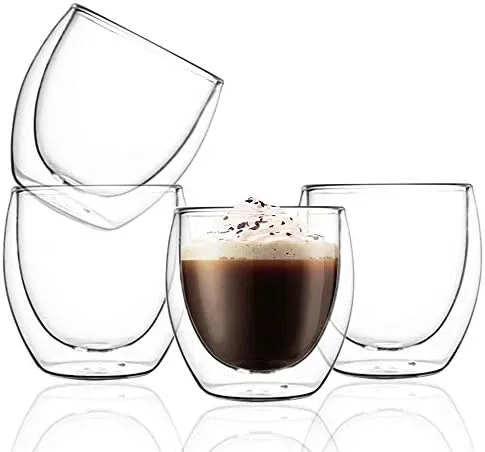Introduction
Crafting delicious cocktails is an art, but it’s also a science — and mastering the science of drink-making starts with understanding the fundamentals. Enter: glassware 101. Whether you’re a bartender-in-training or just an enthusiastic home mixologist looking to up their game, having the right glassware can make all the difference in your drink presentations — and your guests’ experiences. From brandy snifters to tumblers, this guide will provide you with an essential introduction to various types of glassware and their uses for every home bartender.
The Different Types of Glassware
Having the right glassware is essential in order to create a pleasing atmosphere, as well as allow drinkers to enjoy and savor their beverage. From glasses designed to keep drinks colder for longer to glasses that give off a pleasant aroma, different types of home bar products can have a big impact on the taste and temperature of your drinks. With such a wide selection available, you won’t struggle to find the ideal glassware for your next occasion. Get everything you need now; home bar supplies like these are key in making sure everyone enjoys themselves.
1- Beer Glasses
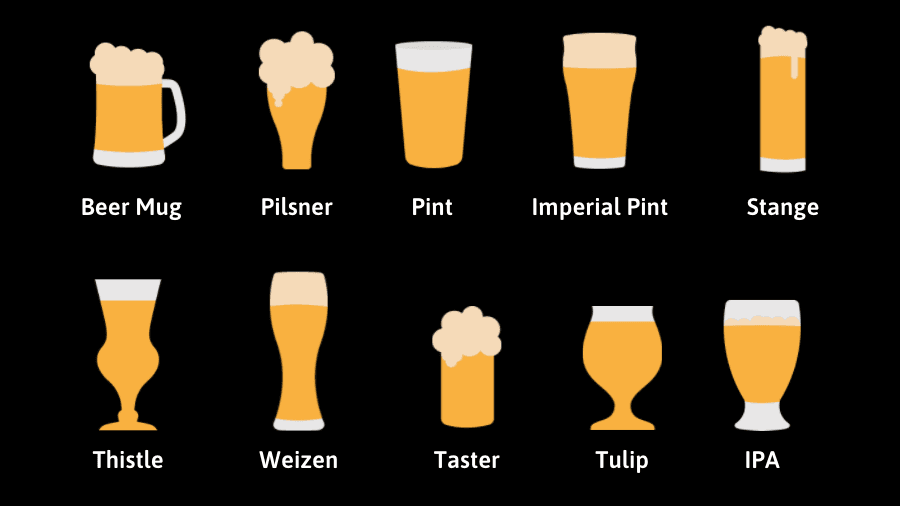
Different Types of Beer Glasses (Glassware)
Traditional Pint Glasses
Basic pint glasses are tall, tapered and have straight sides. They usually hold 16 ounces, which is enough room for a full bottle of beer and its foamy head. In the freezer, pint glasses can be chilled to bring warm beer to a cold temperature that is suitable for drinking. As well as serving as a mixing glass in a Boston shaker set, this glass is a workhorse in the bar.
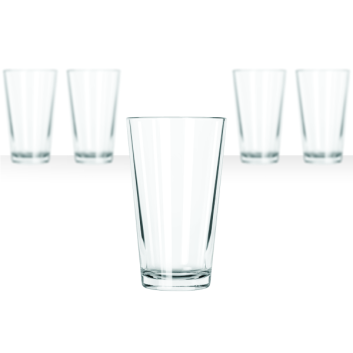
Imperial Pint Glasses
In a similar manner to traditional pint glasses, imperial pint glasses hold up to 20 ounces of beer, but they are larger than American pint glasses. Ales, lagers, and stouts are highly recommended for this type of pint glass since it has straight sides that taper out and has a small lip at the mouth to make drinking easier.

Blue Pint Glasses
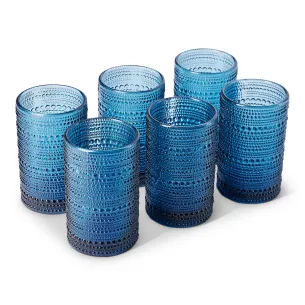
Beer Mugs
Beer Mugs are great as they prevent your beer from getting warm when you hold onto it. The thicker base also means they can handle a knock on the bar top. They are often seen in bars, ranging in size – 10 to 14 ounces – with some of the ones featuring a thicker base holding just 10 ounces. The shorter pour offered by those might make it worth ordering a bottle, particularly if you don’t mind if it’s draught.
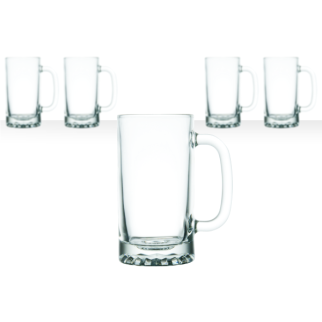
Pilsner Glasses
Because of their unique shape, Pilsner glasses stand out from other glasses. They are tall and skinny but widen at the top and are crafted to show off the golden hue of a pilsner, while maintaining the head and trapping in essential flavors. The ounce capacity of this type of beer glass is 14 ounces, which is slightly smaller than a pint glass’s capacity.
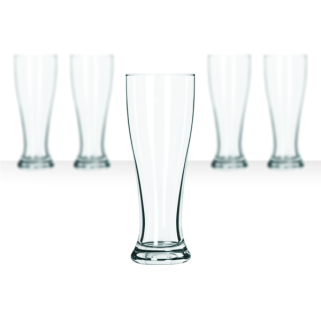
Stange Glasses
Despite being narrow and straight, this beer glass perfectly describes its shape, which is called a pole. In addition to preserving carbonation and maintaining flavor, this glass has a sturdy base that is very reliable. The typical capacity for strange beer glasses is about 6 ounces, but more modern ones are larger.
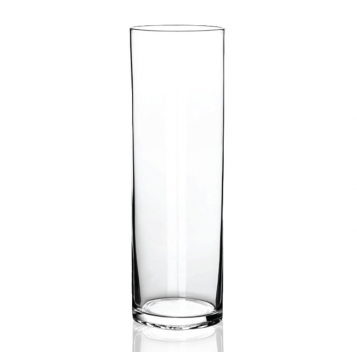
Beer Can Glasses
Beer Can Glasses, shaped just like classic drinks cans, make a unique way to serve cocktails and beer straight from the can.
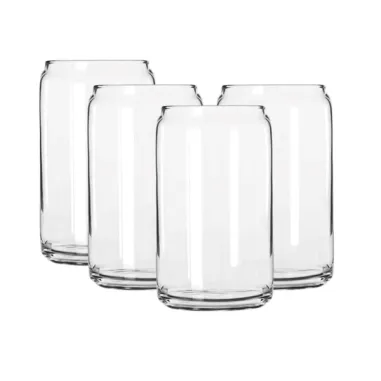
Tulip Glasses or Belgian Beer Glasses
A tulip glass, also known as a Belgian glass, features a bulbous body that tapers at the top to enhance the aroma and flavor of Belgian ales, stouts, saisons, and other ales.

Thistle Glasses
Like tulip glasses, thistle glasses have a wide body that tapers up, but they tend to be angular and taller than tulip glasses. Thistle glasses are typically used to serve Scottish ales.
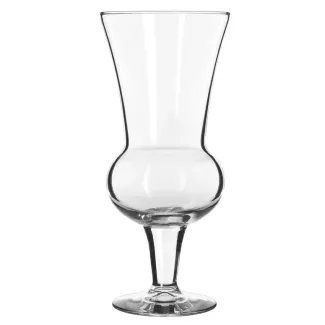
IPA Glasses
IPA glasses are elongated goblets, but ideal for hoppy beers. They typically hold about 19 ounces and have a wide body that tapers at the bottom. You are sure to enjoy a great tasting beer if it has a series of ridges at the base that release all of the flavor and carbonation into the glass, and make the bubbles rise all the way to the very top.
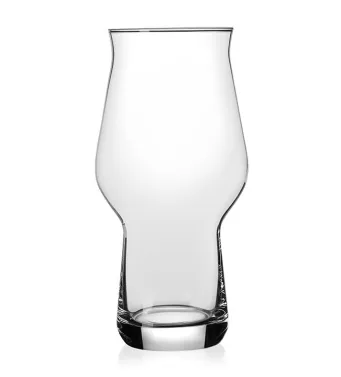
Weizen Glasses
Designed for wheat ale, weizen glasses are tall and slim to really highlight the signature aromas of the beer. These glasses show off the color in an elegant way, and have a wider mouth that gives ample space for the foam to rise up to the brim. They usually hold 17 ounces of liquid.
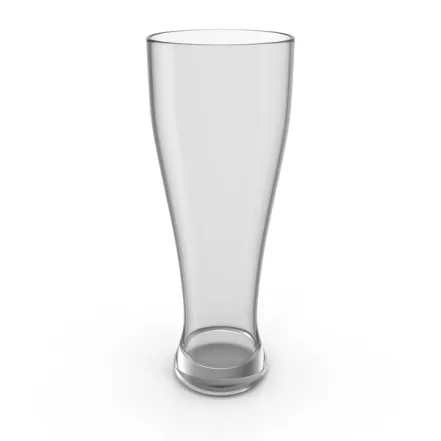
Taster Glasses
This small glass is meant to give people a taste of beer. It comes in many shapes and sizes, but the only difference is its size. It usually weighs between 3 and 6 ounces. You can use these small glasses in beer gardens or breweries when you are unsure of which beer to order, or if you just want to try out a new flavor!
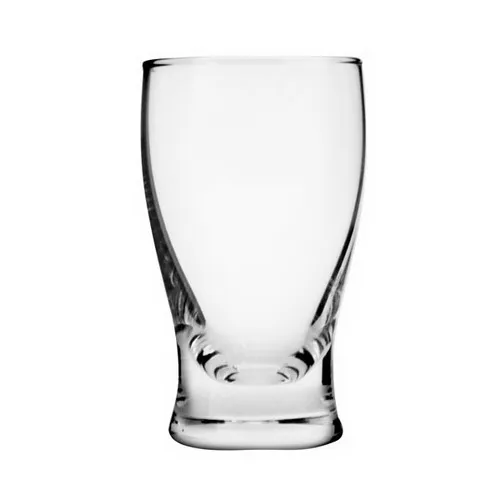
Pitchers
Beer pitchers are containers that are used to store and serve beer. They typically have a spout for easy pouring, and a handle for easy gripping. They are usually made from glass or plastic, and come in several sizes. Party hosts and events that serve beer often use them, and they are especially useful when serving large groups.
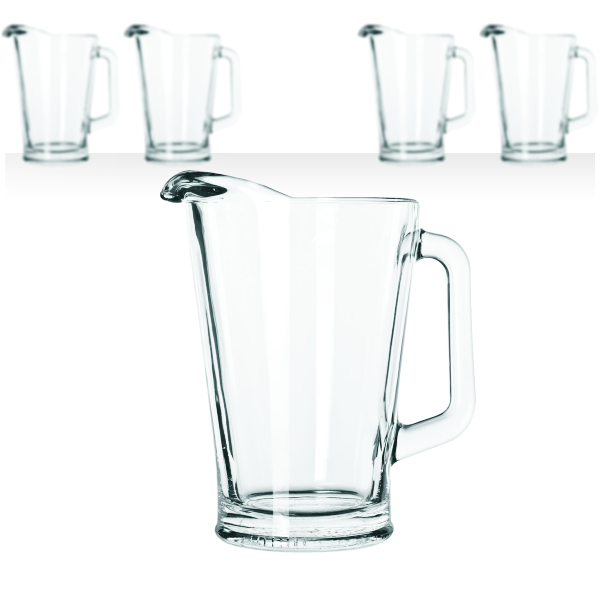
Growlers
A growler is a 32- or 64-ounce airtight beer vessel made of glass that functions like a small keg, and the smaller version is sometimes called a howler. In most cases, you can buy them and have them filled at a brewery. By preserving the beer’s flavor, they ensure you have a tap-worthy beer when it’s ready.

2- Wine Glasses
Wine glasses are quite intricate; there are many shapes and styles that have been developed to best suit a certain type of wine. When distilled down, however, there are two primary glasses; a white wine glass with its taller and more open rimmed bowl and the red wine glass which is rounder with a tapered rim. Stemmed glasses are historically seen in the world of beverage service but lately stemless designs have become popular. This stems from wanting to keep the temperature of the drink constant without influence from body heat. Wine glasses have grown over time as well, often ranging between 8 and 22 ounces (though 5 ounces is a conventional serving). These glasses can be used for different kinds of cocktails; drinks with ice generally fare better in white wine glasses while punch or heavily garnished beverages work best in stemless designs such as Sangria.
Tall Wine Glasses
The small opening of the standard wine glass allows for the flavors of the wine to flow continuously rather than all at once, enhancing the taste of whatever wine you like.
Balloon Wine Glasses
In contrast to other types of wine glasses, balloon wine glasses have an almost spherical shape, which is much more rounded than other types of wine glasses. These glasses are usually used to drink red wines.
Stemless Wine Glasses
Compared to traditional wine glasses, stemless glasses fit perfectly in the palm of your hand. While the glass is designed to hold both red and white wines, some argue that red wines benefit from the warmth of hands around it.
Contour Wine Glasses
Goblet Wine Glasses
Top used Wine Glasses
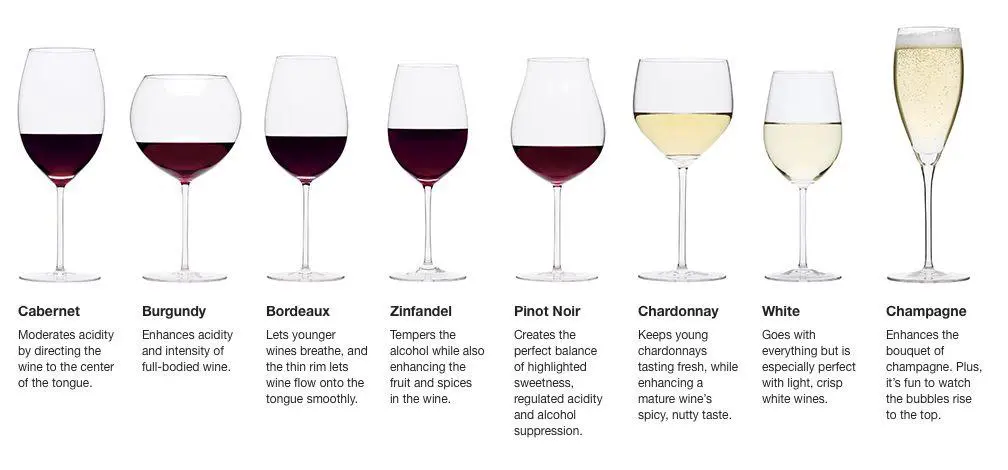
Cabernet Red Wine Glasses
While the rim thickness varies, the narrow mouth accumulates the aroma of the wine and enhances its smell. Cabernet sauvignon glasses are also tall, but not as tall as Bordeaux glasses.

Burgundy Red Wine Glasses
Burgundy wine glasses have a broader bowl than Bordeaux glasses, and a narrow top. The thin rim makes it easy to sip, and the broad bowl encourages the aromas of delicate wines to accumulate. This design directs wine to the tip of the tongue, allowing the drinker to detect flavor nuances. Lighter, more delicate red wines: Beaujolais, Red Burgundy, Dolcetto
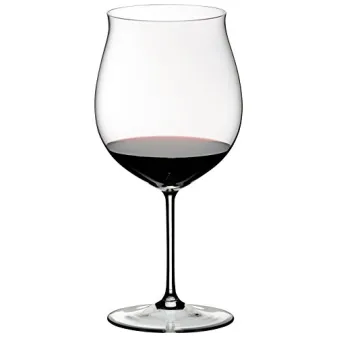
Bordeaux Red Wine Glasses
The Bordeaux glass is uniquely designed to accommodate the characteristics of full-bodied red wines that have high tannin levels. It is the tallest type of red wine glass, with an elongated stem and a broad bowl that is not as wide as other glasses. This design helps to dissipate ethanol on the nose by keeping the wine at a distance from the mouth and also allows for more oxygen to soften bitterness in these types of wines like Petite Sirah, Cabernet Sauvignon and Cabernet Franc, Malbec and Bordeaux blends. In addition, it directs the flow of the liquid to the back of your palate, reducing tartness while optimizing flavor.
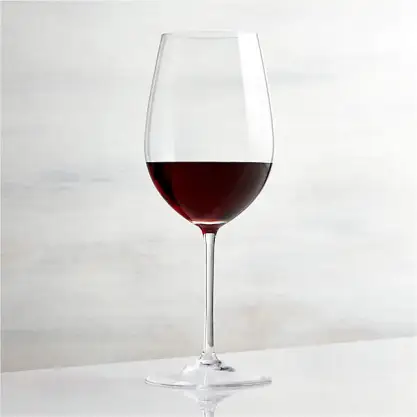
Zinfandel Red Wine Glasses
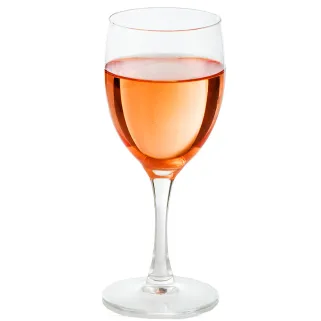
Pinot Noir Red Wine Glasses
In similar fashion to a Burgundy glass, a pinot noir glass is characterized by its wide bowl. The wide bowl allows the wine to interact unhindered with the air, improving its flavor and aroma.
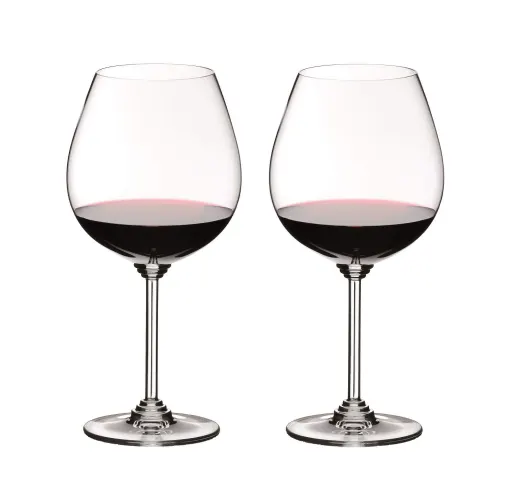
Chardonnay White Wine Glasses
Typically, chardonnay wine glasses have a larger opening, allowing the wine to reach the tip and sides of the tongue. Thus, the palate can detect the sweetness of the wine. Finally, the wine glass balances the aromas and tastes well. The bowl provides just enough aeration to concentrate the aromas while the larger opening balances out the sweetness and acidity of the palate.
Type of wine: full-bodied wines: Chardonnay, Semillon, Viognier

Viognier White Wine Glasses
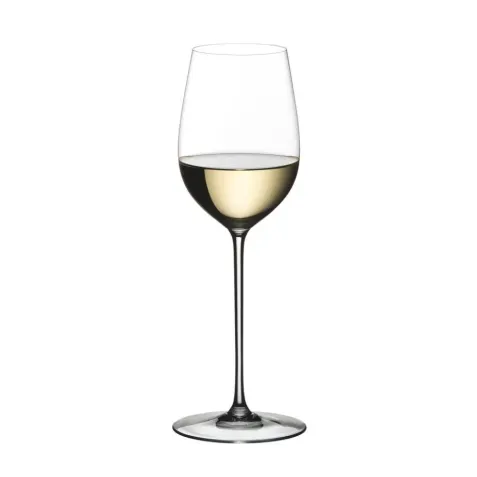
Wine Decanters
Decanters are traditionally used to hold wine, specially for momentous occasions. With their wide bottom and tapered neck, they help aerate and oxygenize wine by filtering out any sediment and bitter taste of preserved wines. Over time, various designs and shapes have come into existence to make them even more attractive and unique. On the other hand, carafes are elongated vessels meant to serve water, juice, or wine in general. In a nutshell, while they both appear similar in structure and use, a decanter stands out with its specialized purpose of aerating wine.
Carafes
A carafe is a regular liquid storage vessel with an elongated body and a small base that can store a lot of liquid without taking up much table space. Carafes are used more commonly to hold liquids such as water, juice, and wine
3- Champagne Glasses
You might want to invest in a set of Champagne glasses if you enjoy a Champagne cocktail every once in a while. They come in various shapes. It is generally best to purchase a set of 4 or 8, depending on your average Champagne celebration.
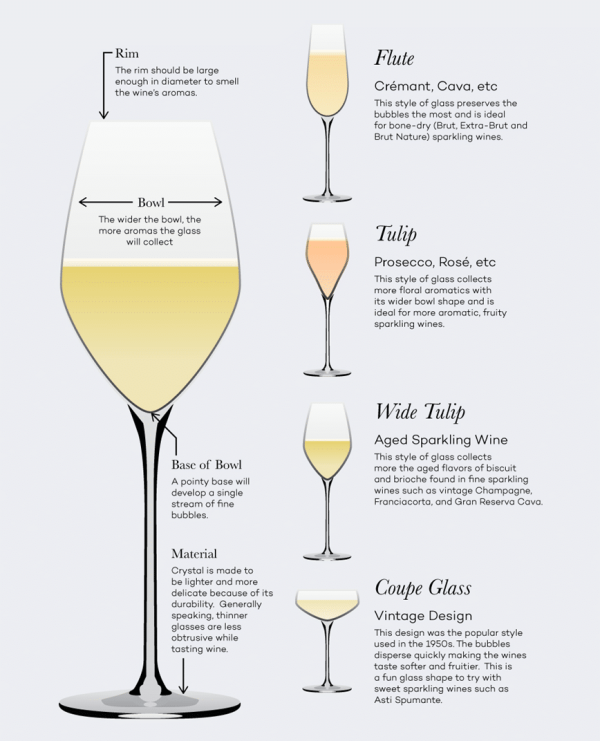
Tall Flutes
Flutes typically hold 7 to 11 ounces and have a tapered rim that keeps the Champagne’s bubbles in the glass longer. Champagne flutes can also be used to display garnishes. The fizzy fountain of the traditional Champagne cocktail is spectacular in a flute when spiraled into the glass. It looks stunning when the lemon twist is spiraled inside and the simple addition of a single berry garnish appears elegant.
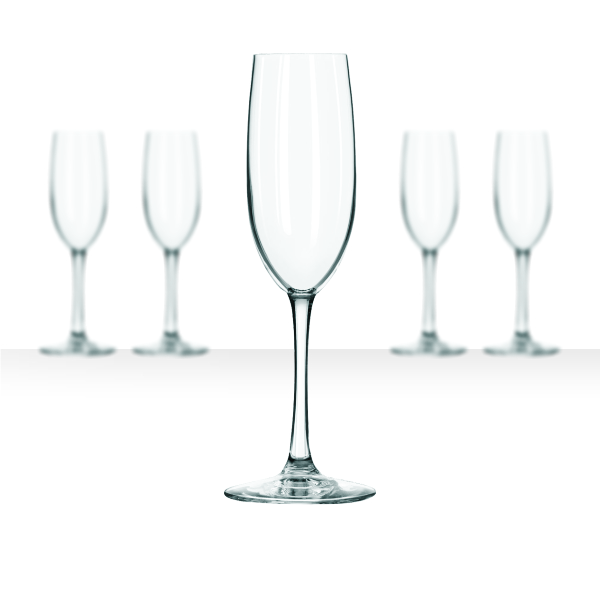
Twisted Stem Flutes
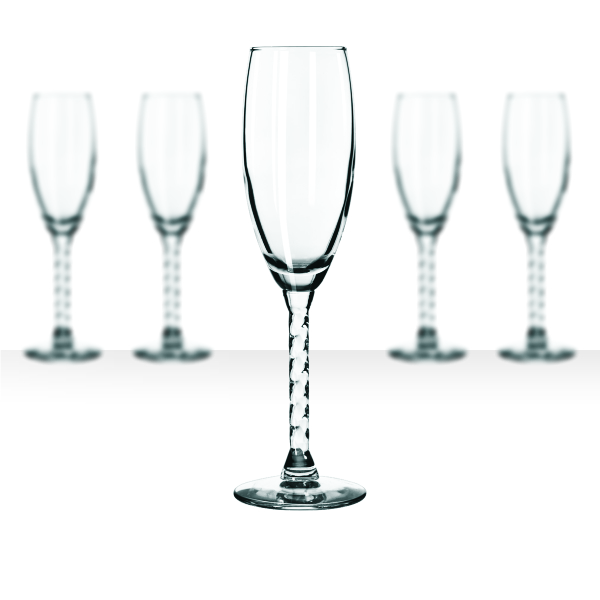
Stemless Flutes
Featuring a slender bowl and narrow rim, stemless champagne flutes enhance the bouquet, taste, and effervescence of champagne, prosecco, mimosas, sparkling wine, or any fruity fizz.
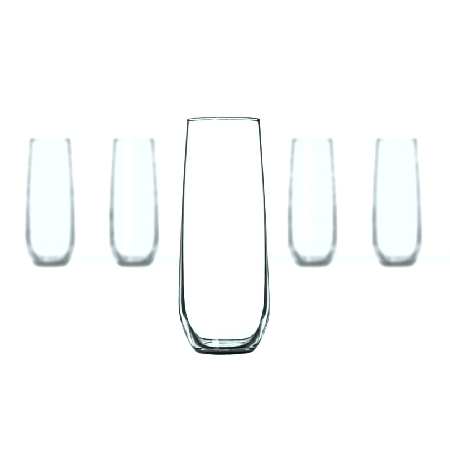
Champagne Tulip Glass
A Champagne tulip is also an elegant option. It has the same stem and bowl shape as a flute, but the rim flares out instead of in. This design will not trap bubbles, but it works well for mixing Champagne with other sparkling wines.
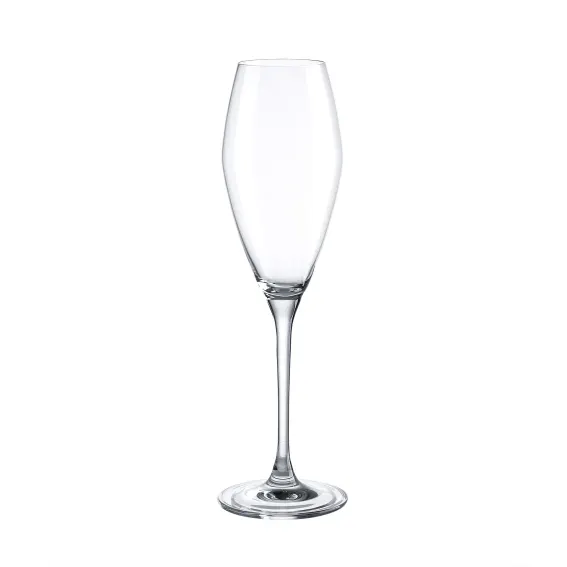
Champagne Saucer Glass
The Champagne saucer is also known as a coupe glass. With a flatter, rounder bowl, it is a more traditional glass design for serving sparkling wines. Saucers are great for serving straight Champagne to many guests. You can also use them to float large slices of fruit on top of drinks you normally would serve in a cocktail glass. They provide a vintage touch to drinks that would normally be served in cocktail glasses.
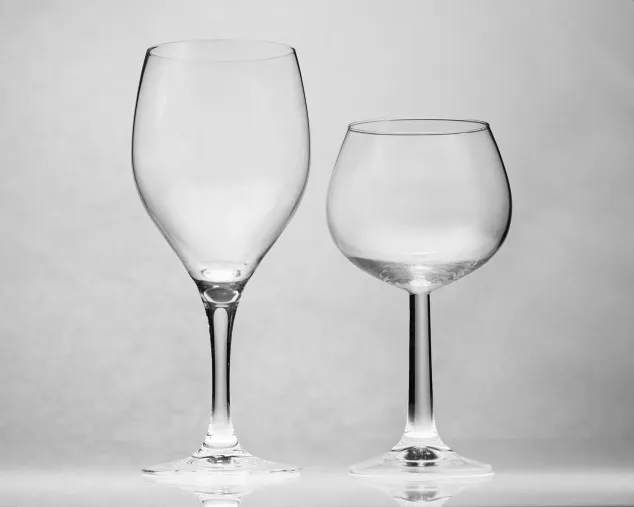
4- Shot Glasses
In the bar, shot glasses are very recognizable. They can be collected and are fun to collect. They can hold straight shots and mixed shooters and can be used as a replacement for a jigger when measuring drink ingredients. A few shot glasses are always a good idea just in case some break. The average shot is 1 1/2 ounces, while the short shot or pony shot is just 1 ounce. Some shot glasses hold 2 ounces.
Bar Shot Glasses
A typical shot glass is made out of thicker glass, particularly for the base, to avoid it from shattering when it’s slammed on the bar. Stout short glasses are widely used for straight shots of liquor or shooters that are shaken and strained. For showing off the colors of layered shots such as a B-52, tall and thin shot glasses work best. The tallest and thinnest shot glass is called caballito, tailored specifically for tequila. Also, they make an ideal line up of glasses when comparing liquors during a tequila or whiskey tasting. Be mindful that shot glass sizes can be misleading; especially those with thick bottoms which may look bigger but actually contain the same volume as smaller glasses. This is also common in trade with beer mugs; some bars will use this ruse to reduce pour cost and supply less alcohol without alerting their customers.
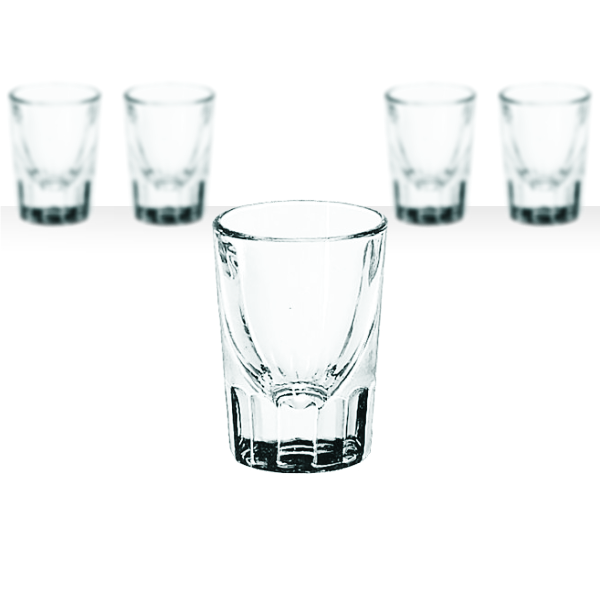
Tall Shot Glasses
Drinks intended to be consumed in a single gulp go in shot glasses, whether you’re entertaining guests at home or playing a game of vodka shots. Shot glasses are an excellent addition to any glassware collection. Since vodka and other strong drinks aren’t meant to be sipped slowly, they’re often served in such types of glassware.
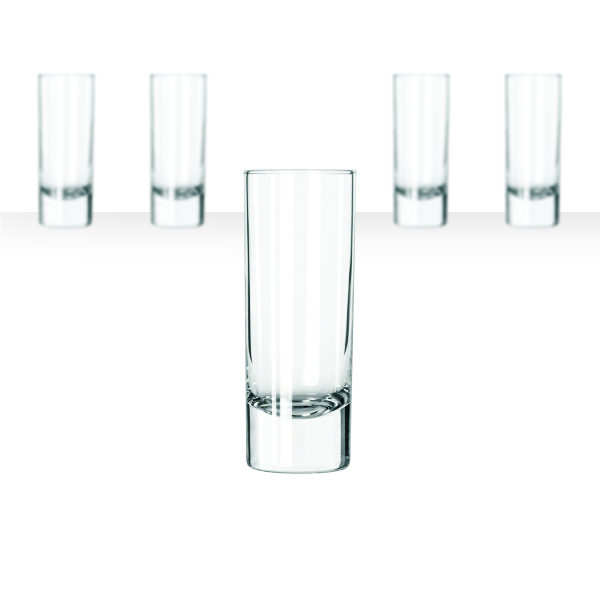
Black Shot Glasses
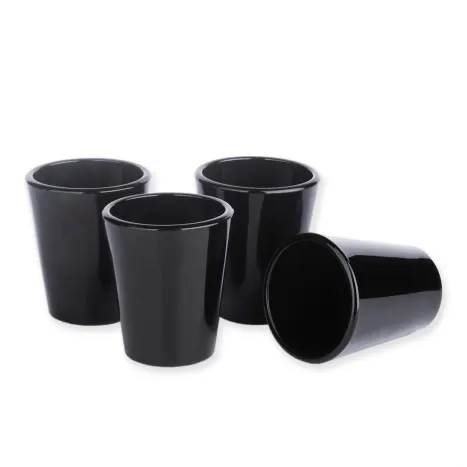
5- Cocktails Glasses
Cocktail glasses come in an array of styles, from frosted to painted, and even stem shapes. Though you may think stemless glasses are more common, the stem does serve a purpose – it allows the drinker to hold their drink without warming up the liquid with their body heat. This is important for keeping non-iced drinks cold for longer.
Rocks Glasses
High-quality spirits are served “on the rocks” or “neat” in rock glasses. In contrast to a shot, these types of glasses contain liquids that take the longest to consume and require a leisurely pace. If you’re going to use a single rocks glass, be sure the bottom is big enough so it can be held for a long time. The old-fashioned glass, sometimes referred to as a “lowball” or “rocks” glass, is a short tumbler with a thick bottom. Commonly used for mixed drinks such as the famous old-fashioned that are served over ice, it can hold between 6 and 8 ounces. A double old-fashioned variant is also available, typically holding up to 10 or 12 ounces, making it suitable for drinks like the rusty nail or a neat pour of whiskey. The larger style glass is perfect for serving mixed drinks like the white Russian, with or without ice, as well as straight liquor with either a large cube or an ice ball. Both glasses suitable for cocktails using only these two styles are a great choice for bars needing to conserve space.
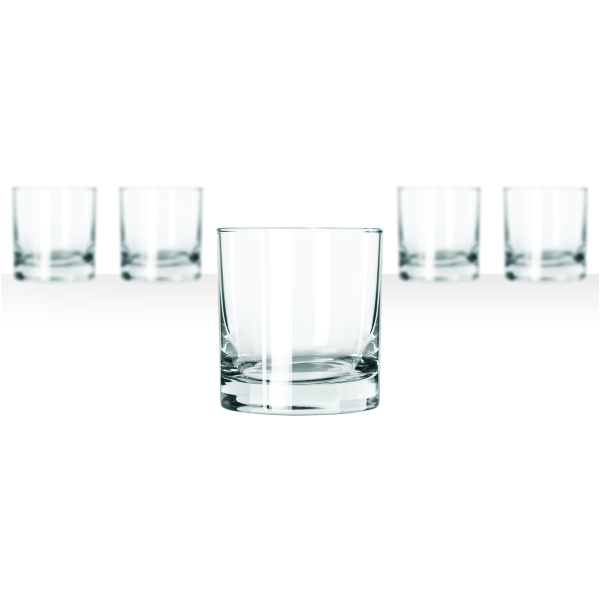
Highball Glasses and Collins Glasses
Highball and collins glasses are practically the same; they can both be used for tall drinks and generally hold 8 to 16 ounces. These glasses are very similar in shape, however, the collins glass is taller and more like a chimney, whereas the highball is more stout, capping off at 10 ounces. These drinking vessels are invaluable in any bar setting for mixed drinks – from a shot of liquor mixed with juice or soda to a bloody Mary. At home, they also work wonders as everyday glasses for non-alcoholic beverages like soda, juice or iced tea. Despite their large size, these glasses usually only contain enough liquid to fill them up almost to the brim with ice. The extra ice helps keep the beverage chilled while being consumed and dilutes it at a slower rate than if no ice was added.
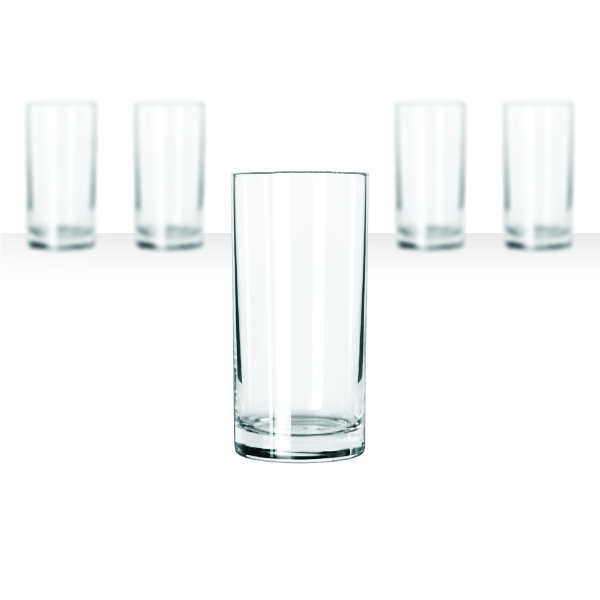
Hurricane Glasses
This glass is shaped like a hurricane lamp, which is how it got its name. It typically holds between 10 and 12 ounces and is used for cocktails like the hurricane cocktail and pia coladas.
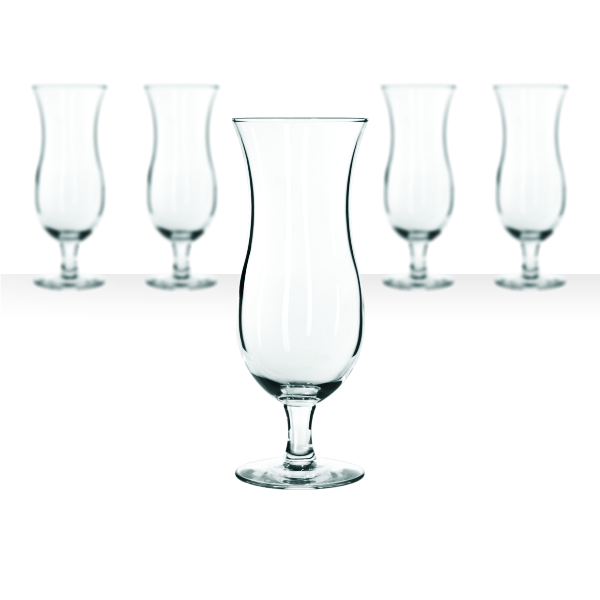
Snifter Glasses
The snifter glass is associated with brandy, typically when one wants to sip it straight. Despite the size of the vessel allowing a standard pour of approximately 2 ounces, the idea behind it is so that all aspects of this drink can be experienced: Watching it swirl within the bowl, examining its legs and color, appreciating its aromas and savoring each sip. It is also suitable for a few cocktails, such as B&B. To conserve space but still recognize the qualities of brandy in full, smaller variations exist; these often maintain the same wide bowl shape but stand taller with a capacity of 6 ounces.
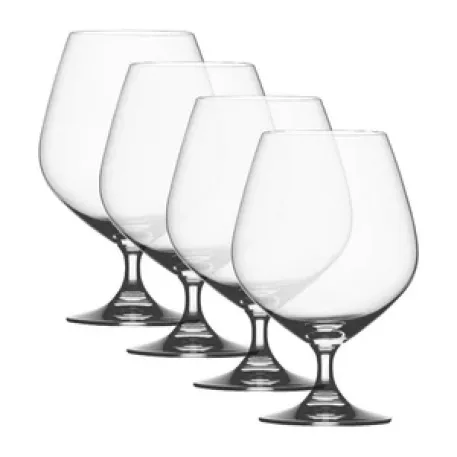
Sour Glass
It is a miniaturized version of a white wine glass. Ideal for whisky sours and other flavorful cocktails, the sour glass holds between 3 and 6 ounces.
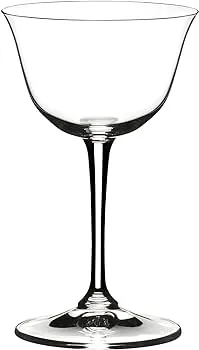
Cordial Glass / Pony Glass
Cordial glasses make great collectibles due to their small size (2 – 3 ounces) and varied styles. Some tulip-shaped, others looking like a sour glass. Genever even has its own stemmed glass which is the perfect design for the Dutch custom of drinking it: ice-cold with a sip taken directly off the top without using hands. Grappa is served in glasses with a round bowl at the bottom and tapered rim while schnapps’ stemware resembles a sour glass that abruptly flares out at the rim. Sherry and port, as well as other fortified wines, are enjoyed from stemware similar to a white wine glass.
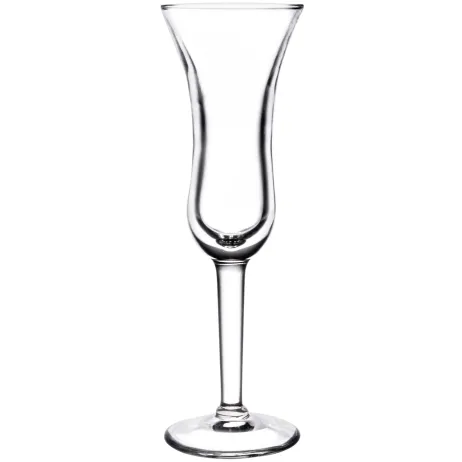
Liquor Decanters
In a quality liquor decanter, an airtight seal prevents oxygen from passing through, preserving the quality of the craft spirits inside as if they had just been put in the bottle.
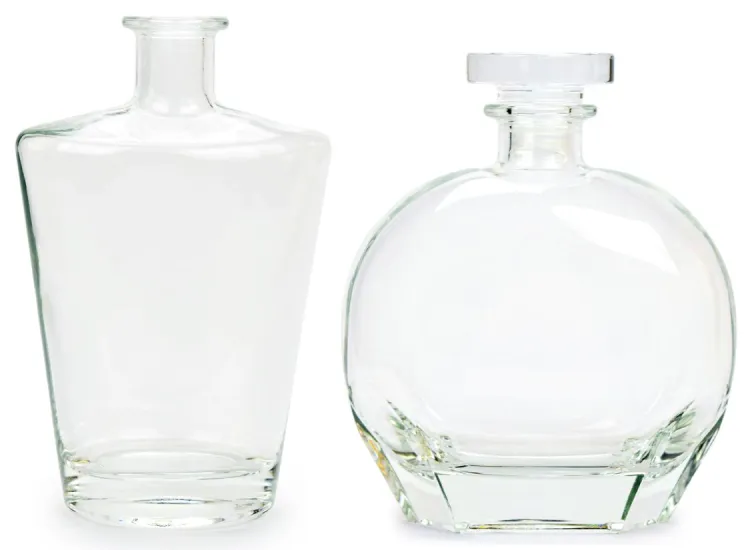
6- Martinis Glasses
Classic Martini Glasses
A subtype of cocktail glass, a martini glass features a v-shaped cup, a long stem, and a circular base. Although the shape of a martini glass is distinctively ornate, it was primarily designed to be functional, as the stem prevents the person holding the glass from warming the drink with their hands.
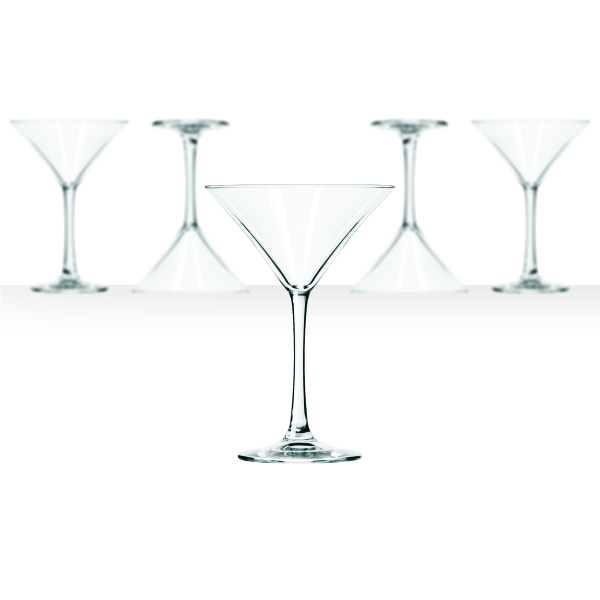
Stemless Martini Glasses
This Stemless Martini Glass has a wide brim that benefits the vodka and gin by allowing them to flourish with an aroma – a crucial component that is neglected when served in a narrow glass. A pick of olives can be supported by the steeply sloped sides of the cocktail, which prevent ingredients from separating
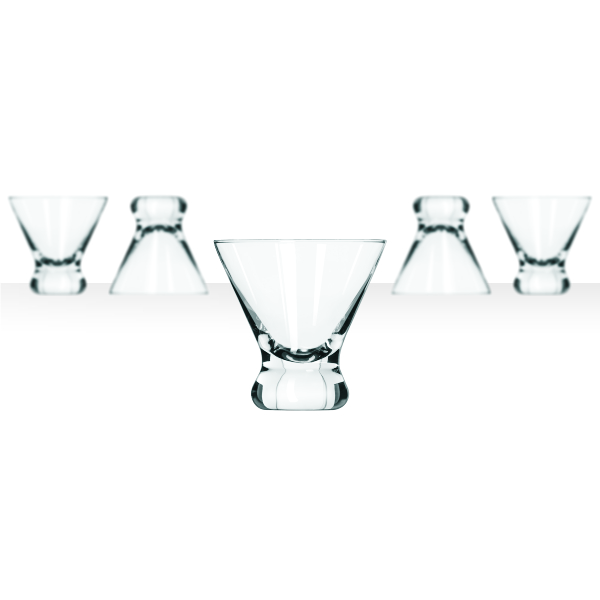
Z-Stem Martini Glasses
A Z Stem is an unusual vessel because it is strong yet light. They can hold 9 ounces of your favorite drinks. They are also perfect for fruit frappes or light desserts.
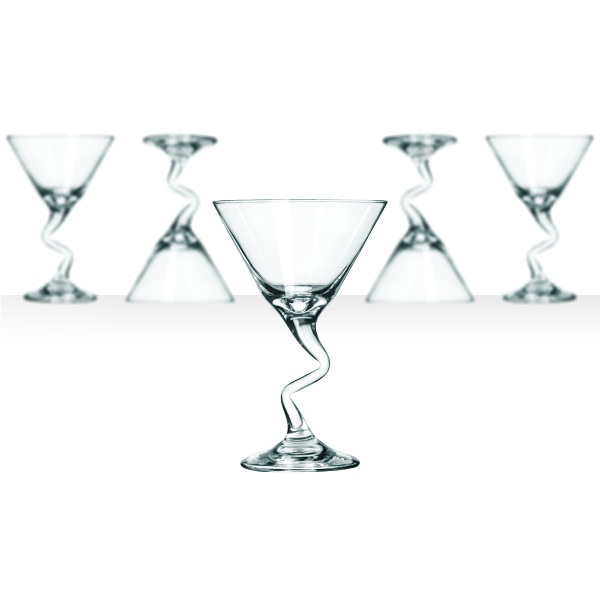
7- Margarita Glasses
Classis Margarita Glasses
The margarita glass is used to enjoy this popular drink, its iconic double-bowl style adding a touch of fun. The wide rim makes it simple to line with salt or sugar, although not necessary; they can also be served in a cocktail, old-fashioned or highball glass. Margarita glasses come in an array of sizes – 6 to 20 ounces – with smaller ones perfect for drinks without ice and the medium sized ideal for frozen drinks. It’s the larger bowls that are good for big blended creations or those with plenty of ice. There are even crazily large versions at 60 ounces which would be more suited for sharing among a group of friends with their own straws!
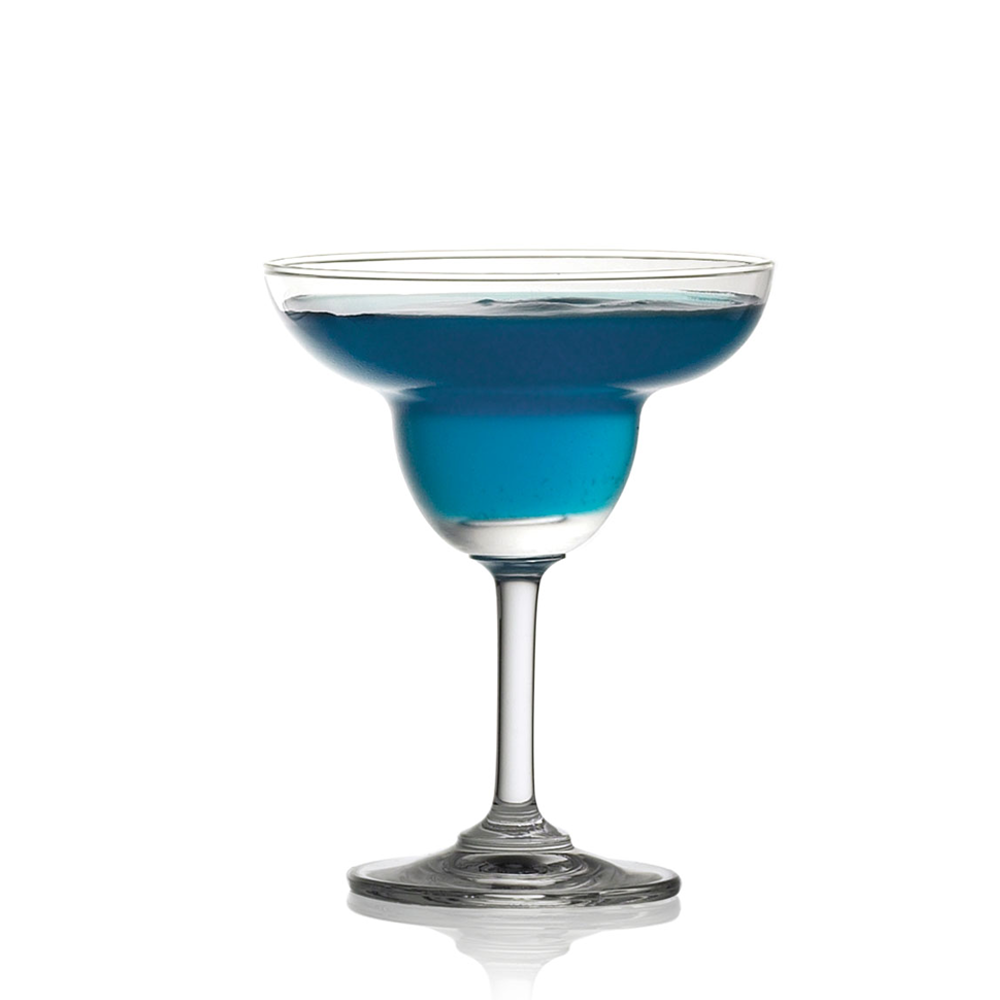
Cactus Margarita Glasses
Cactus Margarita Glasses, shaped like a green cactus, bring you closer to Mexico without leaving your home! Use these glasses for your party guests to sip your favourite cocktail. To give your margarita a Mexican twist, these 35.5cl cocktail glasses feature a green cactus-shaped stem.
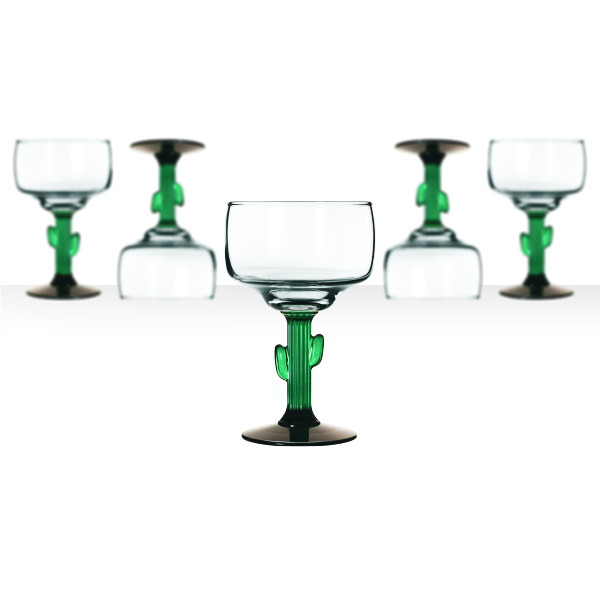
8- Coffee
Regular Coffee Mugs
A coffee mug is a type of cup typically used for drinking coffee. Coffee mugs are usually made of ceramic or porcelain, and many have a handle to make them easier to hold. Some coffee mugs have designs or logos on them, while others are plain. Coffee mugs are typically used for hot beverages, but can also be used for cold beverages such as iced coffee or tea.
Coffee mugs come in a variety of sizes, from small to large. They can also be found in different shapes, such as round, square, or oval. Some coffee mugs have lids to keep the contents hotter or colder for longer periods of time. Coffee mugs are often used in offices and homes, and some people collect them as a hobby.

Irish Coffee Mugs
It’s a footed glass with a handle, used for hot drinks and, traditionally, Irish coffee. It’s made from thick, heat-resistant glass and holds between 8 and 10 ounces.

Espresso Cups (Glass)
Glass cups are the perfect choice for those who appreciate being able to admire their coffee or espresso in all its color and clarity. Such a visual treat is further enhanced by the fact that glass doesn’t absorb flavors or stain, making it easy to keep clean. However, one drawback of using glass is its inability to hold heat well; your beverage will cool off quickly if you take your time drinking it. Nonetheless, this might not be an issue if you prefer cold drinks over hot ones; for connoisseurs of cold brews or iced coffee, glass is the way to go! On top of that, glass cups make for a sustainable selection as they are composed entirely from natural materials that can be recycled without limit. Even if you drop or damage it, there’s no need to worry – just send it off for recycling and soon enough another glass cup will emerge from the process.
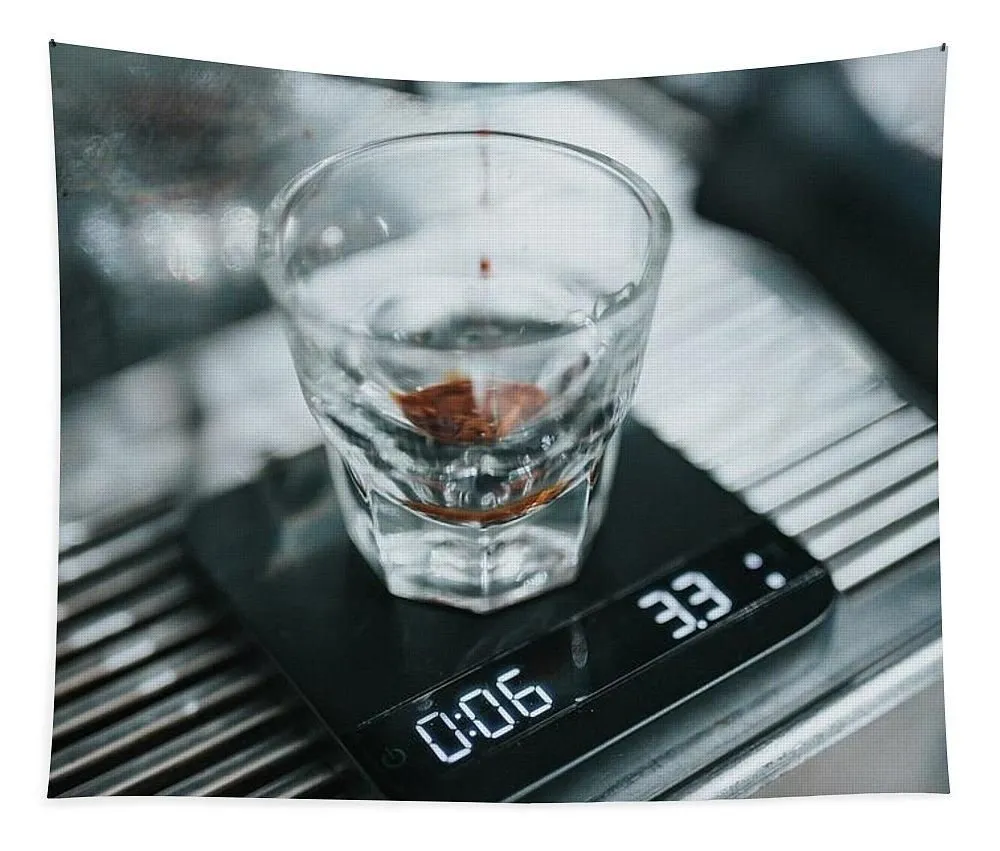
Cappuccino Cup (Glass)
Because of its smaller capacity, the cappuccino cup can be a little more challenging to use for creating latte art. The cup’s base is wider so that more foam can be added to the cappuccino without the cup overflowing. The cup is traditionally six ounces in size and has a wide base. To incorporate milk foam throughout your drink, cappuccinos are usually served with a spoon, just like espressos.
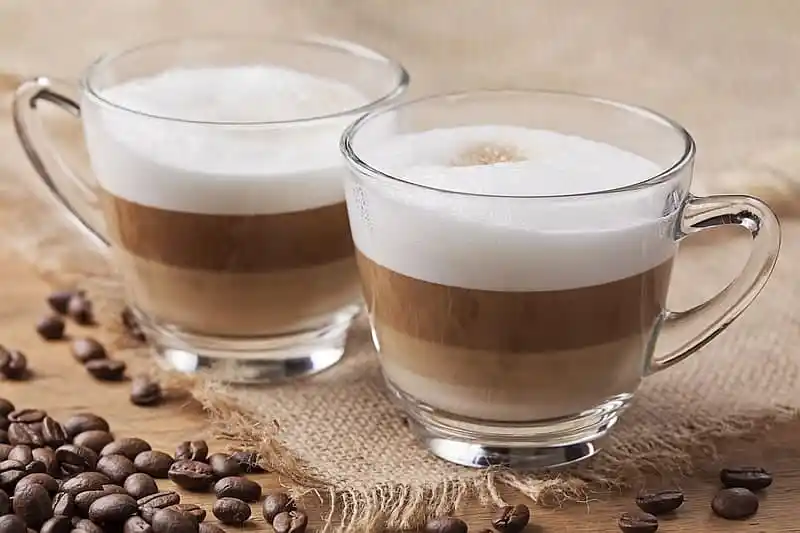
9- Water / Juice
Tumblers / Mixing Glasses
Tumblers are a top choice for casual eateries, and being made of plastic, they also make ideal options for high-traffic organizations such as educational institutions, healthcare facilities, and prisons. These glasses come in all sizes; from a mere 5 ounces up to over 30 ounces. Restaurants usually opt for two standard sizes: 16 ounce and 20 ounce tumblers. Characterized by their simple structure – straight sides, no handle or stem, and flat bottom – tumblers provide practicality without sacrificing style.
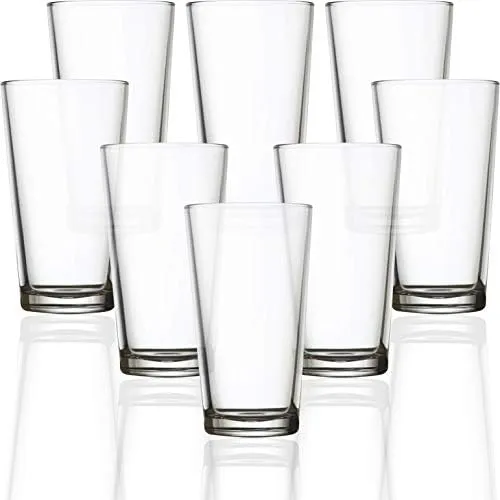
Goblet Glasses
Goblet glasses are perfect for serving water or iced tea at banquets and catered events. They feature a wide bowl on top of a short stem and are sometimes used at higher-end bars to serve beer. Be careful not to confuse them with tulip glasses, which are intended for Belgian ales and dark beers (see our Types of Beer Glasses Buying Guide or Craft Beer Glasses guide). The typical height of goblet glasses is six to nine inches, with a bowl diameter between three and six inches. Make sure you purchase a dishwasher rack that can accommodate these dimensions – they usually hold 10 to 14 ounces.
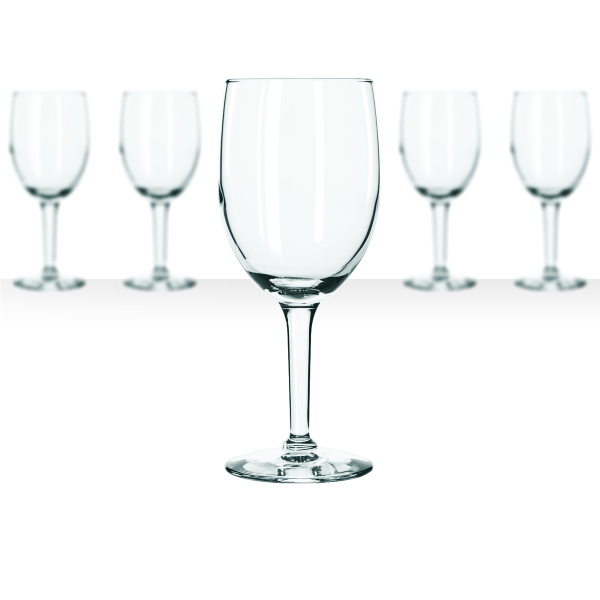
Juice Glasses
Juice glasses are aptly named, as they are perfect for serving juice. Their smaller size makes them especially ideal for freshly squeezed juices during breakfast and brunch. Available in several designs, these glasses can really accentuate and present bright juices, sometimes being used interchangeably with low-ball glasses. The standard height of a juice glass is usually no more than five inches, with capacities usually between three to seven ounces.

10- Jars
Handled Mason Jars
Traditionally used for drinking, this mason jar with handle can also be filled with candy or flowers for a complementary tabletop accessory.
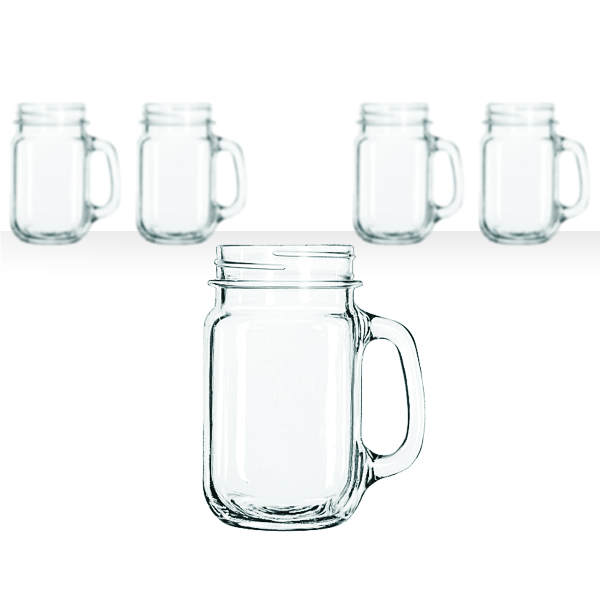
Large Storage Jars
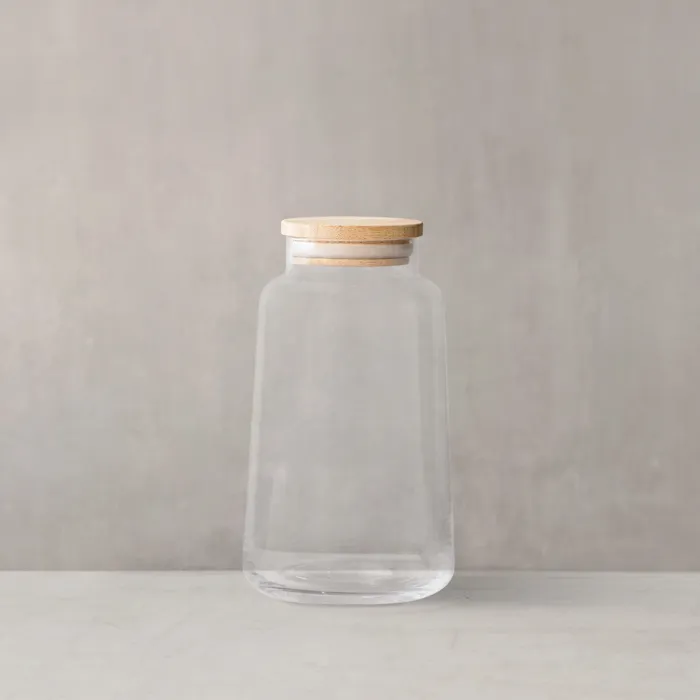
11- Votives (Candle Holders)
A votive candle is a small, short candle that can stand on its own and burns into the candle holder that it’s placed in. Sometimes sold in clear glass holders, votive candles are most commonly white and unscented
Cylinder Votives
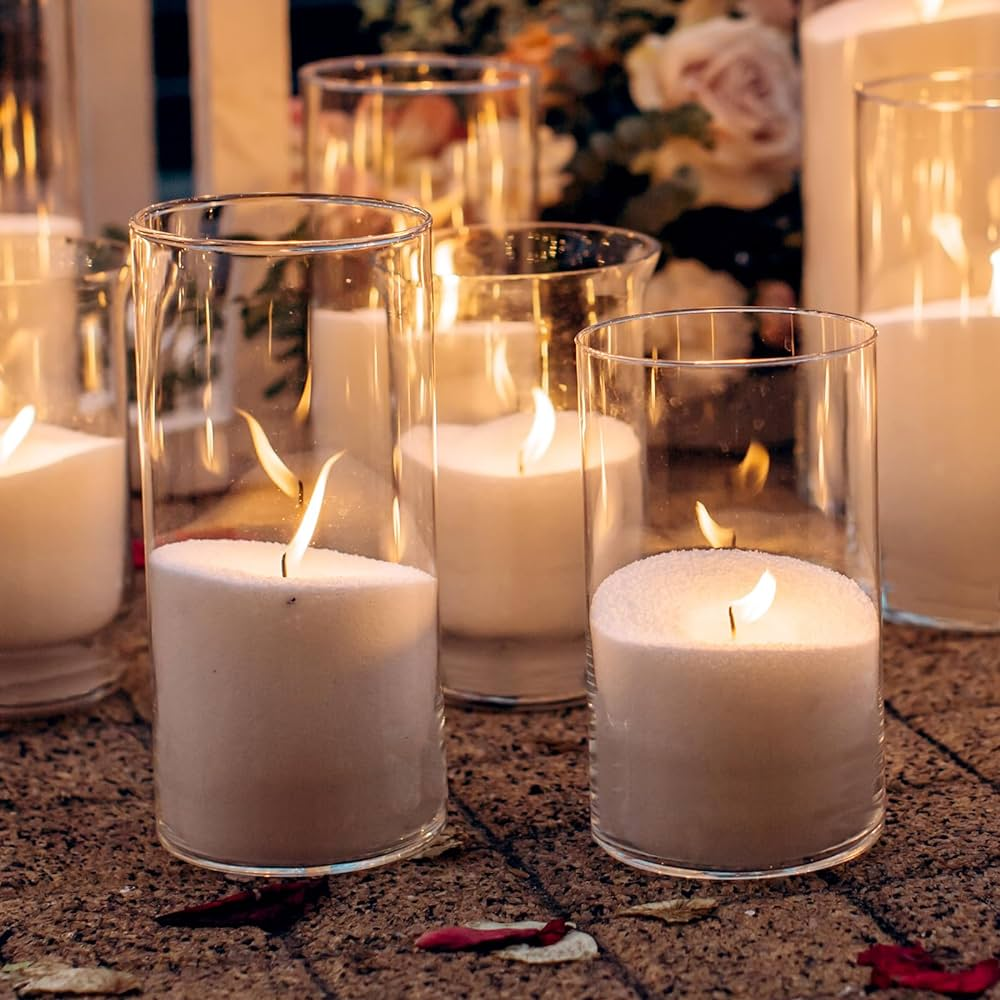
Small Square Votives
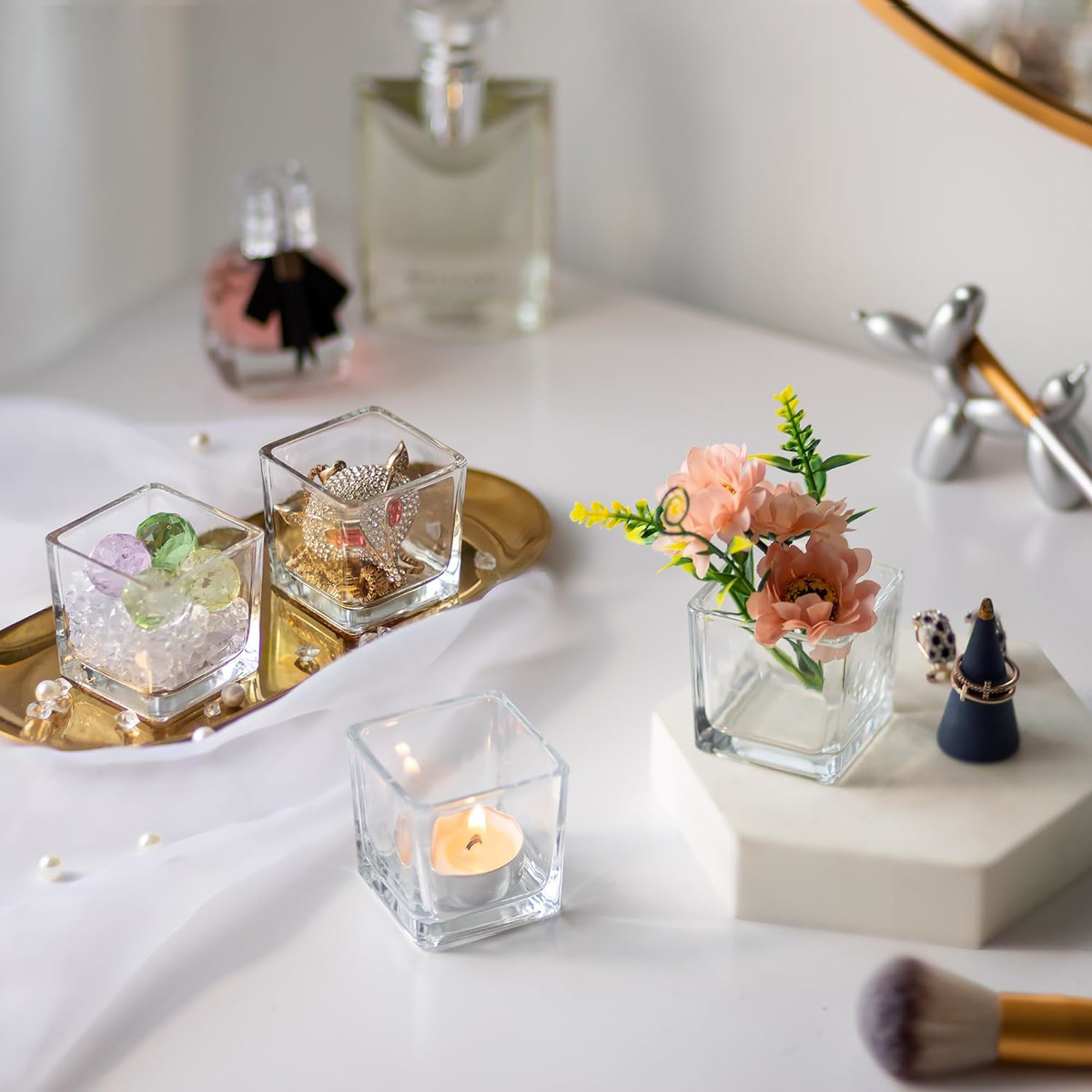
Balloon Votives
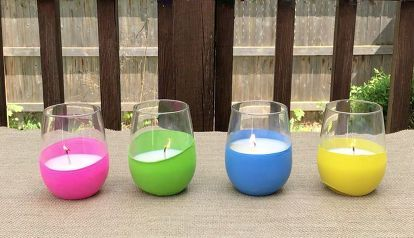
Large Cube Votives
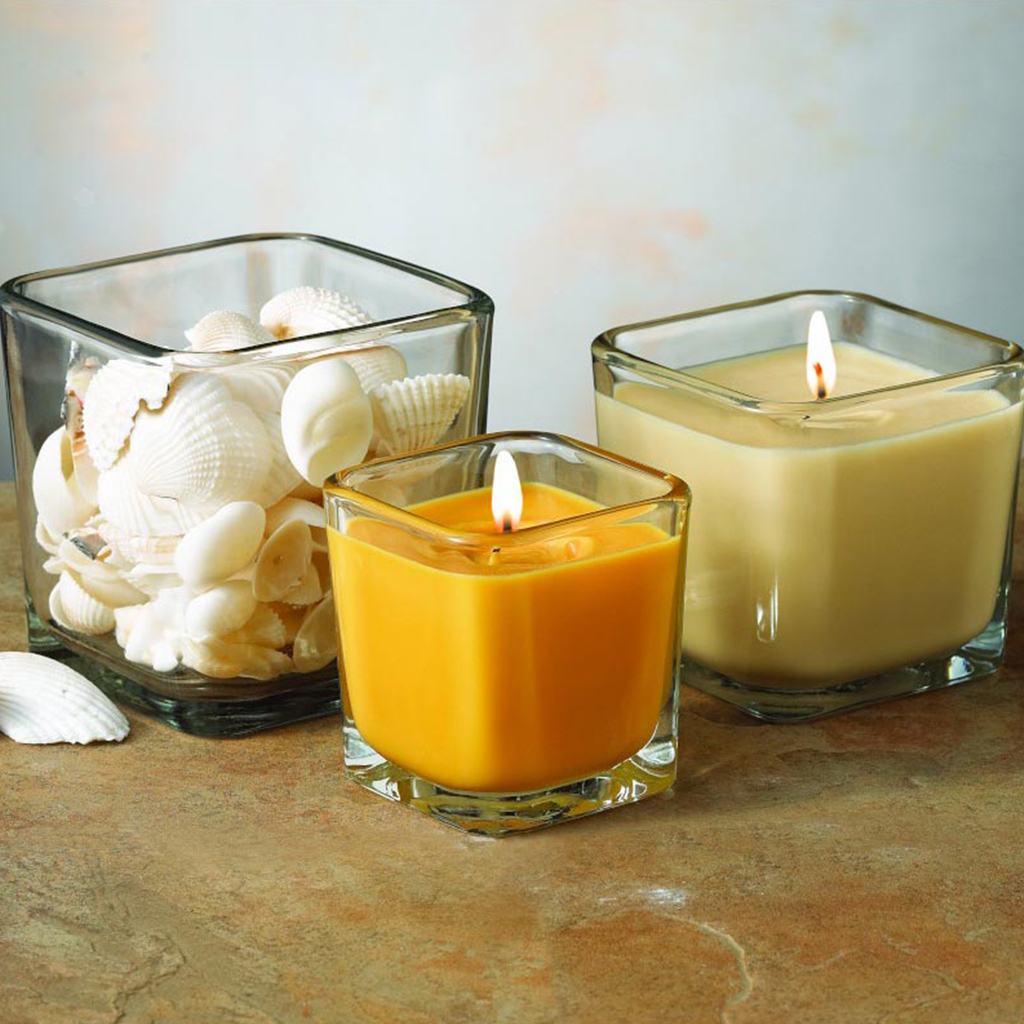
12- Vases
Cylinder Vases
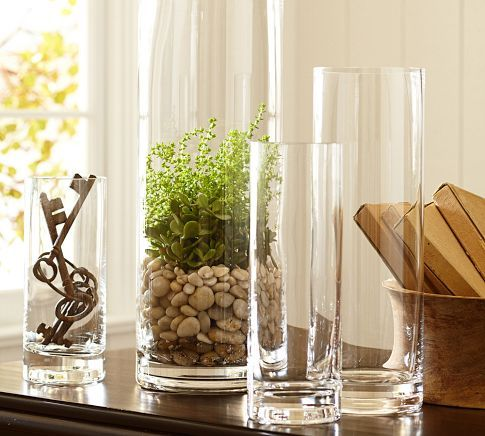
Balloon Vases
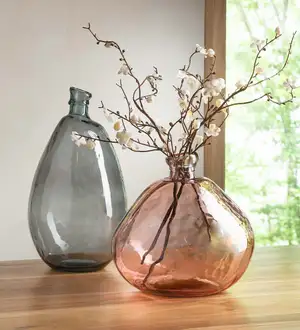
Stem versus Stemless
There are two main types of glassware: stemless and stemmed. Stemmed glassware typically includes a foot, a stem, and a bowl, while stemless glassware only has a bowl. Each type of glass has its own benefits and drawbacks.
Stemmed glassware is more elegant and sophisticated than stemless glassware. It is also easier to hold and drink from because the stem prevents your hand from warming the drink. However, stemmed glassware is more fragile and difficult to clean than stemless glassware.
Stemless glassware is less likely to break than stemmed glassware. It is also easier to clean because there are no nooks and crannies for dirt and bacteria to hide in. However, stemless glassware is not as elegant as stemmed glassware and can be more difficult to hold onto because your hand can warm the drink.
How to Choose the Right Glass for Your Drink
When it comes to choosing the right glass for your drink, there are a few things you need to take into account. The first is the type of drink you’ll be serving. Different drinks call for different types of glasses, so it’s important to know what you’ll be making ahead of time. For instance, cocktails are typically served in martini glasses, while wine is usually served in stemware.
Once you know the type of drink you’ll be serving, you can narrow down your glass options. From there, it’s simply a matter of finding glasses that fit your personal style and budget. With so many different types and styles of glassware available on the market today, there’s sure to be something that fits your needs perfectly.
The Best Glassware for Every Occasion
There are many different types of glassware available on the market, and it can be difficult to know which one is right for you. This guide will help you understand the different types of glassware and how to choose the best one for every occasion.
The first thing to consider when choosing glassware is the type of drink you will be serving. Different drinks require different types of glasses, so it is important to know what you will be serving before you purchase any glasses. For example, wine glasses are designed specifically for red or white wine, while champagne flutes are designed for sparkling wines.
Once you have selected the type of drink you will be serving, the next thing to consider is the occasion. Glassware can be very specific to an event or occasion, so it is important to make sure you are selecting the right glass for the right event. For example, formal events such as weddings or business functions may require more formal glassware, while casual get-togethers may call for more relaxed and fun glassware.
Finally, consider your own personal style when choosing glassware. There are many different styles and designs of glassware available, so it is important to find a set that matches your own personal style. Whether you prefer classic and elegant designs or more modern and contemporary styles, there is a set of glasses out there that is perfect for you.
How to Care for Your Glassware
To keep your glassware looking its best, it is important to follow a few simple tips. First, always wash your glasses by hand using a mild detergent. Avoid using harsh chemicals or abrasive materials, as these can damage the glass. To prevent spots, rinse your glasses with clean water after washing. When storing your glassware, be sure to use a soft cloth to avoid scratching the surface. Lastly, avoid exposing your glasses to extreme temperatures, as this can cause them to break. With proper care, your glassware will continue to look great for years to come.
Storing Your Glassware
Glassware can be fragile and easily damaged. To avoid potential breakage, always store your glassware in a safe place away from areas of high heat or moisture. Shelving systems with adjustable dividers are great for organizing glasses of different sizes and shapes. To prevent scratching or chipping, line the shelves with cloth or felt before placing the glassware on them. Additionally, you can use a cupboard insert or tray to protect your glasses from being knocked over in storage.
Conclusion
Many home bartenders find themselves overwhelmed by the vast array of glassware available. We hope this introduction to types of glassware provided you with a better understanding of all the various options out there and inspired you to create some delicious drinks in your own home. Once you feel comfortable with the basics, why not experiment with new glasses or try infusing flavors into spirits? With practice, who knows what exciting concoctions you might be able to come up with!
Disclaimer
We do not support underage drinking, excessive drinking, binge drinking or any other unsafe drinking behavior. Always drink responsibly. DO NOT drink and drive. This article is not intended to give any advice about alcoholic beverages.
